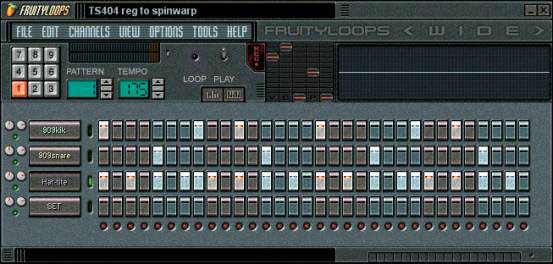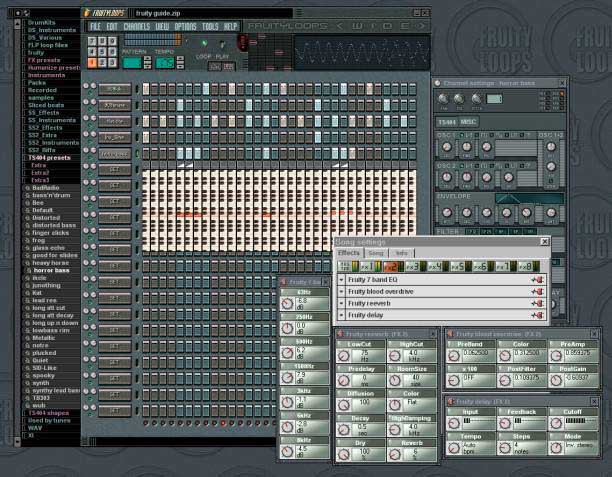| Software Music Machine Archive |
|
Writing drum 'n bass in FruityLoops: an introduction
The Spinwarp Introduction to Writing Drum n Bass with FruityLoops
download the sample fruity file here.
Spinwarp.com is a great resource for those of you into electronic music as well as drum and bass. There are some great tutorials and tips available. You can also download some fine MP3s.
Spinwarp was formed in 1998 by daniel p (pixeloid, chaomorph, nuns with guns, vitriol, heathen earth). Tending towards the faster, darker styles of dnb with a strong focus on live video and visual sampling, Spinwarp have performed live at Frigid and Basscode, released four promo CD's, and appear on two compilations to date. Introduction
Fruity Loops has been my staple software diet for nearly two years, after a long Cubase habit (which I still binge on occasionally). This rough guide is intended to get those new to programming drum n bass tunes off to a quick start. For more advanced tips and techniques, check out spinwarp.com Basic Beats
I usually start a track by knocking up a quick drum loop over which to experiment with basslines etc. More often than not I rebuild these beats later on. The first thing you'll want to do is get a bog standard two step pattern going, which gets the track off to a quick start. Drop a kick drum on channel 1, snare on channel 2 and closed hat on channel 3. Any sample will do for now. Then create a pattern that looks like this (I usually use 32 step patterns and 175-180bpm):

Of course you can use more interesting drum patterns, but save this for later when the track is taking on more form. At this point I usually add about 15 empty channels so the sample browser is nice and long and then using the right mouse button, try out a whole range of drum sounds until I get a combination that works well. This usually involves tweaking the cutoff, release and volume envelopes - particularly for snares. A great snare technique is to layer two snare samples and adjust the attack of one and the release of the other so that you get a 'morphing' effect with the 'snap' of one snare and the tail of the other. Tuning the hats is another good tweak to make at this stage. Adding Some Sub Bass
I like to fill the low end pretty quicky so I can start messing around with strange noises and overdriven sounds as soon as I can, so go through the Fruity Loops instruments -> shapes -> basic folder and drag one of the sine shapes onto a channel. When you do this, make sure you set 'Use loop points' and adjust the instrument volume envelope. I also like to add some LFO 'warbling' to give the bass that club-shaking effect:


You might find it best to tweak the envelope and LFO with a pattern playing so drop something like this into your bass channel: 
I also find that pitch makes a big difference to volume on these clean basslines so, depending on your speakers, adjusting the volume of each note can be a good idea to even it out - ultimately, well use a compressor to deal with this later on: 
Overlaying Synth Lines
Alright, now we have the drums and the bass, everything else is garnishing. So lets start with one of my favourite 404 settings - "horror bass" - and drag it onto an empty channel.
A really good tip for using these lead synth lines is to try to keep them minimal. Its often more brooding and powerful to have more gaps than notes in your non-bass elements rather than pumping out fast complex 'melodies' (for want of a better term!). Something like this is what I 'm referring to: 
And while this is looping, tweak the filter, envelope and distortion settings on the 404 until you get a nice organic, albeit hard, sound. When this is sounding good, patch the channel through FX bus 2 and we can start messing with it a bit.

I find the 404 is generally only useful when run through several effects and in this case I'd use an EQ, Bloody Overdrive, delay and possibly reverb. The EQ would usually have a lot of the bass and top treble bands sucked out and the mids boosted- this can give it a nice harsh quality which will work well with a high pass filter. The overdrive can be fairly subtle, the reverb even more so and the delay just a slight echo to give the sound more 'space'. 
Preparing for the Arrangement
Now comes the fairly boring stage which we could have avoided at the beginning, but which would have slowed us down if we had. There is a price for everything When you have a loop that you are pretty happy with, break it down into as many patterns as there are channels. That is to say create a new pattern for every sound and name them accordingly like I have done here:

Now you can start experimenting with different variations on each pattern as well as combinations of them.
Composition
This is really where this rough guide leaves off. Whilst there are a few standardised 'DJ-friendly' arrangement structures you can use, there is a lot of work involved in getting the song to 'work' without being too repetitive or too disjointed. As a general guideline you can follow this structural 'template'.
1. The Intro
The intro can be a simple ramp up into the beat or a slow build with lots of atmospheric and incidental sounds. This is generally the place to be experimental as once the beat drops, you have to keep people dancing and DJ's nodding or else you'll be mixed out when things go wrong... I usually give it 30 seconds or so - long intros tend to give me the shits.
2. Setting the Scene
Bring your beat in, gradually build on it- not too slowly. Vary the beat every 4 or 8 repetitions with fills or 'ghost' snares (see spinwarp.com for more info on ghost snares!) Bring in you bassline- maybe suggest it more than anything, don't use up all your good stuff here. When you're a couple of minutes into the track, time for the first breakdown.
3. The First Breakdown
This should be short and sweet- lose the drums except maybe for hats or shakers. Drop the melody or theme and let an atmospheric sound or reversed crash or something lead you into the first drop.
4. The First Drop
Bring in your bass line at maximum effect and hurry your beats up with some double time hats, tambourines or shakers (quiet!). This section should be more powerful than the first beat, but still working up to the climax
5. The Second Breakdown
Let this breakdown occur more gradually than the first and take longer to build back into the second drop. A vocal sample can work here with some good atmospheric sounds reversed pads, reverb, flangers- whatever! (Need tips for atmospherics? Check spinwarp.com again! J) This breakdown is probably 2/3 into the track and builds to a bigger climax than the first breakdown.
6. The Second Drop
Bring everything back in at full capacity. Fast, bangin and with lots of energy. Modify the bassline slightly. Use a different snare. This section should be reminiscent of the first drop but not sound the same. Bring in a new synth line or atmos sound. Alternate between drum patterns, drop snares here and there- keep it at a climax as long as possible. This is where the track should be at its fattest and more often than not this section is essentially the pattern you originally wrote in Fruity Loops with a few things crowded around it.
7. The Outro
The outro is more often than not a slow peeling off of the layers than made your second drop. I recommend adding something new and different in the outro just to spice it up. Don't drag it out too long, either- 20 bars should be plenty, but feel free to leave some pads or reverb going so DJ's can mix in the next track if they'd left it running this far!
Here's a screenshot of my playlist for "confusion" which more or less fits this schema (it's not a very complicated track!):

Mastering Your Track
A few general tips for squeezing your track out at the end. I really love Steinberg Freefilter, which you need to use in Wavelab. This will help you EQ your whole track similarly to any other track you specify. Its awesome for getting that 'Bad Company' sound into a flat mix! T-Racks is also pretty damn good for a final compression on a track, but you don't need to spend your dough on these commercial apps to polish off your tune.
First off, before you even render your Fruity Loops file to a wav or MP3, put all your drum channels through the same FX bus and put them through a compressor. A ratio of 2, attack of 5ms, release of 200ms and threshold of -13 db is a good starting point for settings, but tweak it till it sounds right. I use KwikCompressor and mda Multiband, but there are a lot of free and very good VST plugins available (check: http://www.hitsquad.com/smm/cat/PLUGINS_VST/ for links).
A subtle reverb on drums can also take the edge of them and make them more fluid sounding. Use a very minimal amount of 'humanise' on your hats' volume (not pan) to take a little of the mechanical-ness out of them as well.
If you also put an equaliser, compressor and limiter (in that order) on your master plugin bus then you effectively have a 'mini-T-racks' inside FruityLoops. You can then export your mastered wav file for final tweaking in an editor before converting to MP3 and upping it to your site.
Conclusion
OK, so it's a very cursory and sketchy introduction. I'm not saying you'll be the next Tech Itch if you do everything I say (coz it sure as hell hasn't worked for me ;-) but hopefully it will help a few of you get up and running with both Fruity Loops and drum n bass. For more FruityLoops help check fruityloops.net and for more drum n bass production techniques check spinwarp.com (again!). Support Fruity Loops by paying for it- sell your sampler or Cubase if you need to, coz you won't need them again
Spinwarp.com is a great resource for those of you into electronic music as well as drum and bass. There are some great tutorials and tips available. You can also download some fine MP3s.
Spinwarp was formed in 1998 by daniel p (pixeloid, chaomorph, nuns with guns, vitriol, heathen earth). Tending towards the faster, darker styles of dnb with a strong focus on live video and visual sampling, Spinwarp have performed live at Frigid and Basscode, released four promo CD's, and appear on two compilations to date.
Related Hardware:
Cheap Electronic Drum Sets
Share This Article |
Diz grate
EyeBluBBinDizZhit! Thanks, hurzz a tweeny tween ---- I MADE MY FIRST D N B !!!!!!!!! *BIG CHEEZE* LubUguyz, ZEEPMEUPDATEDDDDDbbbbBOOOMMMM!!!